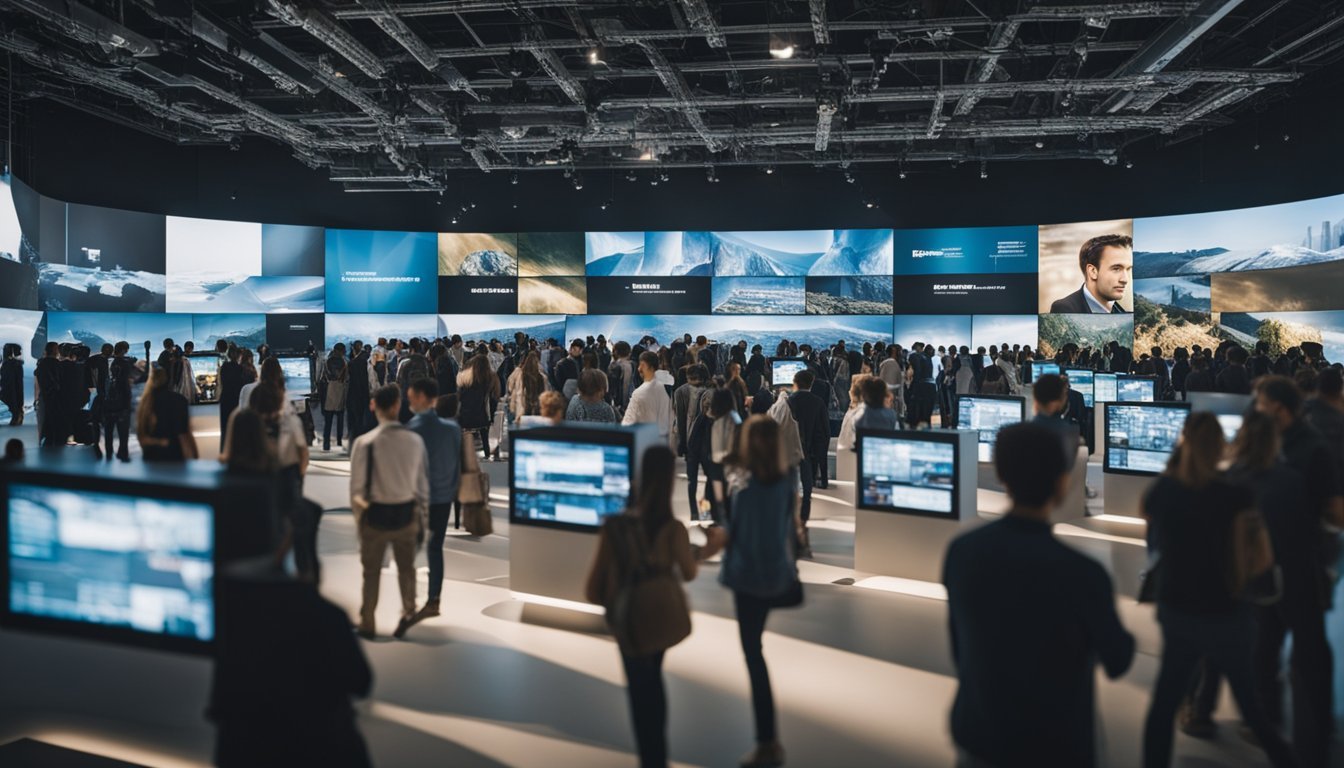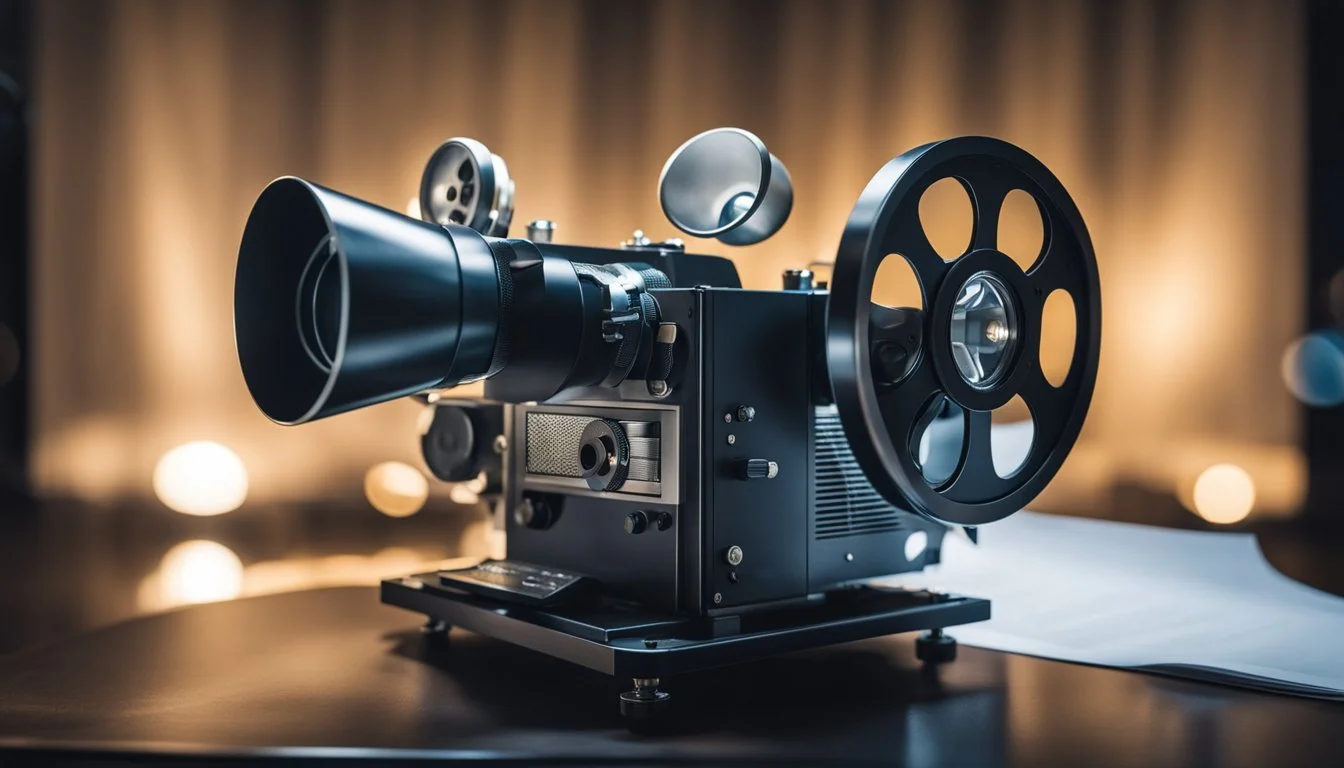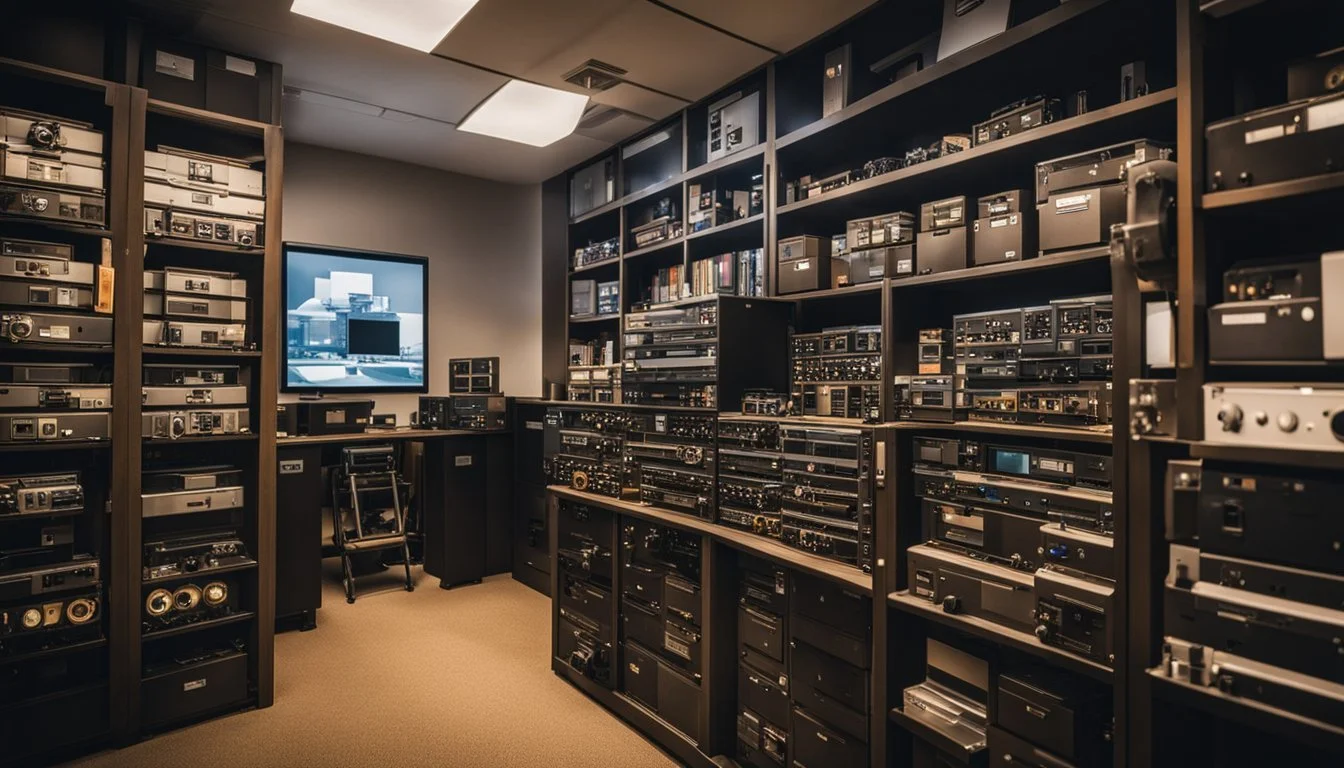Navigating the World of Film Exhibitions and Installations
A Comprehensive Guide
Film exhibitions and installations provide a captivating window into the dynamic intersection of cinema, art, and innovation. These exhibitions offer audiences an immersive experience, transforming traditional viewing into interactive and sensory adventures. Such events, including the inspiring multimedia installations like the "Nebula" exhibition in Venice, challenge viewers to engage with film and video art in novel ways.
Navigating through these exhibitions, one can witness the evolution of film from static presentations to multidimensional encounters. Installations at world expos and influential art institutions—like those at the Musée du Louvre—highlight the power of film to reflect cultural, technological, and artistic trends. These events serve as both educational platforms and vibrant cultural spectacles.
Understanding the history and significance of installation art enriches one's appreciation of modern exhibitions. From the roots of art installations to the role of immersive institutions in today's art world, the journey through these exhibitions not only entertains but also educates, making it a fulfilling experience for enthusiasts and newcomers alike.
The Evolution of Film Exhibitions
The progression of film exhibitions highlights significant changes influenced by technological advancements and audience preferences. This brief yet detailed journey explores the pivotal shifts in how movies have been presented to the public.
Early History and Development
Film exhibitions began in the late 19th century, marked by the first commercial motion picture exhibition in Paris in 1895. Early cinemas, often store theaters, rapidly evolved into grand movie palaces by the 1920s.
These venues were more than just places to watch films; they were architectural wonders that provided an immersive experience. Silent films dominated this period, with live orchestras often accompanying the visual spectacle.
Impact of Digital Technology
Digital technology revolutionized film exhibition in the late 20th and early 21st centuries. The transition from celluloid film to digital projection began in earnest in the 1990s, reducing costs and improving image quality.
The rise of digital cinema also allowed for the easier distribution of films. Additionally, technologies like 3D and IMAX experiences have further enhanced the viewer's experience, making it more dynamic and engaging.
Contemporary Trends
Today, film exhibitions are influenced by the rise of streaming services and on-demand content. While traditional cinemas still play a vital role, audiences are increasingly drawn to the convenience of home viewing.
Efforts to attract viewers back to theaters include luxury seating, gourmet food services, and special event screenings. Additionally, the use of virtual and augmented reality is beginning to offer new ways to experience films, pushing the boundaries of traditional exhibition spaces.
Understanding Installations in Cinematic Arts
Exploring film installations uncovers how cinema transitions from traditional screenings to immersive experiences. As film integrates into museum spaces, the relationship between the environment and the viewer's perception of the medium evolves.
Defining Film Installations
Film installations transform cinematic works into spatial experiences. Unlike conventional screenings, they use multi-channel projections and spatial arrangements. This approach subverts the traditional linear narrative.
Isaac Julien's "Ten Thousand Waves" exemplifies this, with its nine-channel video projected onto double-sided screens.
Jean-Luc Godard's contributions blur boundaries between film and digital media, demonstrating how installations push cinematic boundaries. These works become art objects, challenging traditional cinema's temporal and spatial limits.
Interaction Between Space and Viewing Experience
The environment profoundly affects how viewers engage with film installations. Venues like museums offer unique settings where spatial design and projection technology intertwine.
The Donald B. and Catherine C. Marron Atrium at MoMA, designed for Julien's piece, highlights this interplay. Such spaces shape audience movement and focus, turning viewing into a dynamic act.
Nam June Paik's Global Groove showcases the convergence of cultural elements through installation, reinforcing the idea of a fluid, interconnected global identity.
Viewers may navigate through screens and projections, creating personal narratives. This spatial engagement contrasts sharply with passive film viewing, offering an active, immersive experience.
Preparing for a Film Exhibition
Preparing for a film exhibition involves curatorial decisions, technical setup, and effective publicity. Each element plays a vital role in ensuring the event’s success and audience engagement.
Curatorial Considerations
Curating a film exhibition requires thoughtful selection and arrangement of films. One must consider the theme, genre diversity, and target audience. Selecting films that align with the exhibition's theme can create a cohesive and engaging experience for the attendees.
Developing a timeline for the screening schedule is also crucial. It’s important to allocate sufficient time for each film, ensuring there are appropriate intervals for audience interaction and feedback.
Curators must also plan for any accompanying events, like Q&A sessions or panel discussions, adding depth to the exhibition.
Technical Requirements and Setup
Technical setup begins with securing the appropriate projection equipment. This includes projectors, screens, and audio systems that ensure high-quality viewing experiences.
Venue selection is equally important, as it must support the technical needs of the exhibition. Consider the acoustics, lighting, and seating arrangements to create an immersive environment.
It’s also essential to perform technical rehearsals before the event. This allows for troubleshooting and ensures that all equipment functions smoothly.
Publicity and Marketing
Effective publicity and marketing strategies are key to attracting a broad audience. Social media campaigns can create buzz and drive engagement. Platforms such as Instagram, Facebook, and Twitter are valuable tools for reaching a wide audience.
Email newsletters can also be used to inform subscribers about event details. Collaborating with local influencers and film critics can further enhance visibility.
Traditional marketing tactics, such as posters and flyers, should not be overlooked. Placing these in strategic locations like cafés, libraries, and universities can capture the interest of potential attendees.
Venues for Film Exhibitions
Film exhibitions are held in a variety of venues, each providing a unique viewing experience.
Museums such as the Musée du Louvre in Paris often feature special film exhibitions, showcasing the historical and artistic significance of cinema.
Art galleries frequently host installations where film intersects with other visual arts, creating immersive experiences that engage multiple senses.
Converted spaces like old factories, churches, or even basketball courts are increasingly popular for presenting film works. These venues offer a distinct ambience that enhances the viewing experience.
Traditional theaters remain a cornerstone for film exhibitions, offering a classic setting with professional projection and sound systems.
Notably, digital art venues are becoming prominent, utilizing advanced technology to create engaging, multi-dimensional displays that attract large audiences.
Each of these venues contributes to the evolving landscape of film exhibitions, making cinema accessible and exciting for diverse audiences.
Navigating Film Installation Logistics
Effective film installation logistics involves acquiring necessary permissions and rights, designing the installation flow, and addressing maintenance and security concerns.
Acquiring Permissions and Rights
Film installations often require various permissions and rights to proceed smoothly. Securing theatrical rights is necessary for public screenings.
Copyright clearance is crucial, ensuring all the content displayed is legally permitted. This may involve negotiations with copyright holders.
Location permits are also required, especially for installations in public spaces or recognizable venues. It's essential to work closely with local authorities to understand and comply with regulations.
Finally, legal contracts should be prepared and reviewed by experts to cover potential liabilities and protect creative work.
Installation Design and Flow
A well-designed installation layout enhances the audience's experience. Begin by analyzing the physical space available and determining the optimal placement of screens, projection equipment, and seating.
Attention to acoustics, lighting, and accessibility is vital. Using soundproof materials can enhance the auditory experience, while proper lighting ensures visibility without affecting the display quality.
Create clear pathways for audience movement to avoid congestion. Interactive elements or supplementary displays should be placed strategically to engage viewers without obstructing the main screening.
Careful planning of entry and exit points ensures a smooth flow of visitors.
Maintenance and Security Concerns
Film installations require constant maintenance to ensure everything runs smoothly. This involves regular checks on projectors, audio systems, and screens to prevent technical glitches.
Having a team of technicians on hand during display times can address any issues promptly, maintaining the installation's integrity.
Security is another critical aspect. Installations should employ measures such as CCTV surveillance, barriers, and security personnel to protect both the equipment and the audience.
Additionally, developing emergency protocols for scenarios like fires or equipment failure is imperative. This ensures both the audience's safety and the protection of the installation.
Audience Engagement Strategies
Harnessing effective audience engagement strategies ensures that film exhibitions and installations remain dynamic and appealing. Through immersive experiences, educational programs, and regular feedback, filmmakers and organizers can enhance audience participation and satisfaction.
Creating Immersive Experiences
Immersive experiences heighten a viewer's connection to the film. Integrating multi-sensory elements such as soundscapes, scents, and tactile interactions can make the viewing process more engaging. Utilizing technologies like VR and AR allows audiences to explore narratives in innovative ways.
Interactive exhibits can offer hands-on involvement, drawing visitors into the story. Personalized content enhances engagement further. Keeping these elements current ensures visitors have a fresh and memorable experience.
Educational Programs and Tours
Educational programs can provide context and deeper understanding of films. Hosting guided tours within film exhibitions can offer unique insights into the filmmaking process and thematic elements. Workshops and speakers can cater to different age groups and interests, from students to film enthusiasts.
Interactive workshops can teach participants about screenwriting, cinematography, and editing. These programs add value, making the exhibition not just an entertainment venue but a learning space.
Feedback and Iteration Process
Continuous improvement relies on effective feedback. Encouraging visitors to share their thoughts through surveys, comment cards, and digital platforms helps organizers gain valuable insights. Analyzing this feedback allows for timely adjustments and enhancements.
Implementing a structured iteration process ensures that the exhibitions evolve based on audience preferences. Regularly updated content can address audience suggestions, keeping the offerings relevant and engaging. Feedback helps in refining both the experience and the logistical aspects of the exhibition.
Economic Models of Film Exhibitions
Modern film exhibitions rely on a diverse set of economic models to sustain operations. These include revenue from ticket sales, sponsorships, partnerships, and grant funding.
Ticketing and Revenue Streams
Ticket sales remain a primary source of revenue for film exhibitions. The price of tickets can vary based on factors such as the type of film, screening time, and location of the theater.
Many theaters offer tiered pricing:
Standard tickets
Premium tickets for special screenings or 3D films
Discounts for matinees or bulk purchases
Additionally, revenue can be generated through concessions such as snacks and beverages. Some theaters employ dynamic pricing models to adjust ticket prices in response to demand, leveraging data analytics to optimize earnings.
Sponsorships and Partnerships
Sponsorships and partnerships play a critical role in the financial health of film exhibitions. Companies and brands often sponsor film events or festivals in exchange for marketing exposure and brand visibility.
Key Benefits:
Financial support for operational costs
Increased marketing reach for both sponsors and exhibitors
Common Sponsorship Models:
Title sponsors for major events
Product placement within films or theaters
Collaborative marketing campaigns
These partnerships often lead to mutually beneficial relationships that enhance the cultural cachet and economic viability of film exhibitions.
Grant Funding and Financial Support
Many film exhibitions secure grant funding from government bodies, non-profit organizations, and arts foundations. These funds are often earmarked for supporting independent films, organizing community events, or improving accessibility.
Types of Grants:
Government grants: Federal, state, or local arts councils
Foundation grants: Philanthropic organizations focusing on the arts
Corporate grants: Companies with cultural funding initiatives
Securing grant funding often involves a detailed application process, including business plans and impact statements. These grants help sustain smaller venues and innovative exhibition formats that might not be financially viable through ticket sales alone.
By leveraging multiple economic models, film exhibitions can create a resilient financial framework to support their operations and continue to bring diverse cinematic experiences to audiences.
Legal and Ethical Considerations
In film exhibitions and installations, addressing legal and ethical issues ensures that filmmakers respect rights and maintain integrity. Key considerations include copyright and fair use principles, as well as consent and privacy concerns.
Copyright and Fair Use
Copyright law protects original works, such as films, from unauthorized use. Filmmakers must secure permissions for any copyrighted content used in their exhibitions. This includes music, footage, and images.
Fair use allows limited use of copyrighted material without permission, often for commentary or educational purposes. However, the boundaries of fair use can be complex. Factors considered include the purpose of use, the nature of the original work, the amount used, and the effect on the market value of the copyrighted material.
It is essential to consult legal experts to navigate these murky waters and ensure compliance.
Consent and Privacy Issues
Obtaining consent is crucial when featuring individuals in films. Signed release forms protect filmmakers from potential legal disputes. These forms should outline how the footage will be used and distributed.
Privacy issues arise particularly in documentaries or real-life footage. Filmmakers must be cautious when depicting private citizens, especially in sensitive situations. Blur or anonymize identifying features when necessary to protect individuals' privacy rights.
Respect for subjects not only avoids legal issues but also demonstrates ethical filmmaking practices. Consulting legal counsel for guidance on consent and privacy can safeguard both the filmmaker and the featured individuals.
Archiving and Preservation
Effective archiving and preservation are critical to maintaining the longevity and accessibility of film collections. These processes involve meticulous cataloging practices and robust long-term preservation methods.
Cataloging Practices
Proper cataloging is essential for film collections. This practice involves detailed documentation of each film's metadata, including production details, cast, crew, and technical specifications. Cataloging also includes indexing by themes, genres, and historical contexts for easier retrieval.
Maintaining a digital catalog allows for efficient searching and sorting. Utilizing software databases that support metadata standards such as Dublin Core ensures consistency and interoperability. Regular updates and audits of the catalog are necessary to keep information accurate and complete.
Long-term Preservation Methods
Long-term preservation of films requires both physical and digital strategies. Physically, films should be stored in climate-controlled environments with specific temperature and humidity settings to prevent deterioration. Archival-quality materials should be used for packaging to protect films from damage.
Digitally, films can be converted to high-resolution digital formats. This process includes creating multiple backup copies and storing them in different locations to safeguard against data loss. Digital preservation also necessitates the use of stable and widely supported file formats to ensure continued accessibility.
Future Directions and Innovations
The evolution of film exhibitions and installations continues to be propelled by advancements in technology and a growing emphasis on sustainability. Innovative technologies are enhancing viewer experiences, while sustainable practices are ensuring that exhibitions reduce their environmental footprint.
Emerging Technologies
Cutting-edge technologies are rapidly transforming how film exhibitions and installations are experienced. Virtual reality (VR) allows audiences to immerse themselves fully in the narrative, offering a 360-degree perspective that traditional screenings can't provide.
Augmented reality (AR) overlays digital elements onto the physical world, enriching the storytelling experience. For example, AR can provide real-time data or additional layers of narrative that interact directly with the environment.
Blockchain technology is being explored for its potential to decentralize the distribution and ownership of digital art, offering artists and filmmakers more control over their work. It ensures transparency and security, which is particularly beneficial for limited-edition releases and exclusive screenings.
Sustainable Practices in Exhibiting Film
With climate change at the forefront, filmmakers and curators are considering sustainability as a core aspect of their practices. Energy-efficient projectors and LED lighting systems reduce the carbon footprint of film exhibitions.
Digital platforms for film distribution minimize the need for physical copies, thus lowering material usage and transportation emissions. Moreover, zero-waste events aim to reduce or eliminate waste produced during exhibitions, through strategies like reusable materials and composting.
Film festivals and exhibitions are also beginning to invest in carbon offset programs to mitigate the impact of international travel. This shift not only helps the environment but also aligns with the growing consumer demand for environmentally responsible entertainment options.
Case Studies and Key Examples
Film at World's Fairs
World’s fairs have historically provided a platform for countries to showcase innovations. Canada, for instance, utilized film at international exhibitions to craft a unique national brand. The interdisciplinary research model gathered evidence from visual and textual sources like archival collections, newspapers, and ephemera.
Interactive Installations
Interactive installations have surged in popularity due to social media. Artists aim to create “Instagrammable” works to enhance visibility. These installations offer participants memorable, experiential experiences. With platforms like Facebook and Instagram, interactive art has reached a broader audience.
Digital-Based Immersive Art
Digital-based immersive and interactive art engages multiple senses and creates an enveloping environment. Immersion can be both physical and psychological, where sensory perceptions enhance the experience of presence. Such installations often provide intense, multisensory experiences, engaging participants in unique ways.
Installation Art Versatility
Installation art is versatile, encompassing various approaches, mediums, and possibilities. These artworks can be simple or complex, designed for different spaces like galleries, outdoors, or digital realms. Each installation offers a distinct experience depending on its context and execution.









